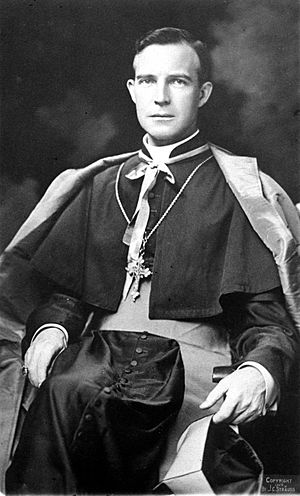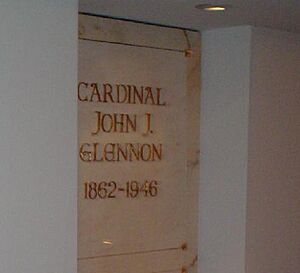John J. Glennon facts for kids
Quick facts for kids His Eminence John Joseph Glennon |
|
|---|---|
| Cardinal, Archbishop of St. Louis | |

Photograph of John Joseph Glennon
|
|
| See | St. Louis |
| Appointed | April 27, 1903 (Coadjutor) |
| Enthroned | October 13, 1903 |
| Reign ended | March 9, 1946 |
| Predecessor | John Joseph Kain |
| Successor | Joseph Ritter |
| Other posts | Cardinal-Priest of S. Clemente |
| Personal details | |
| Born | June 14, 1862 Kinnegad, Ireland |
| Died | March 9, 1946 (aged 83) Dublin, Ireland |
| Previous post |
|
John Joseph Glennon (June 14, 1862 – March 9, 1946) was an important leader in the Roman Catholic Church. He served as the Archbishop of St. Louis from 1903 until his death in 1946. In 1946, he was given the high honor of becoming a Cardinal.
Contents
Early Life and Priesthood
John Glennon was born in Kinnegad, County Westmeath, Ireland. He went to St. Finian's College and then studied at All Hallows College near Dublin. In 1882, he was invited to join the new Diocese of Kansas City in the United States.
After arriving in Missouri in 1883, Glennon became a priest on December 20, 1884. Bishop John Joseph Hogan ordained him. He first worked at St. Patrick's Church in Kansas City. He also studied more in Germany at the University of Bonn. When he returned, he became the leader of the Cathedral of the Immaculate Conception. Later, he took on more important roles in the diocese.
Becoming a Bishop
On March 14, 1896, Pope Leo XIII chose Glennon to be a Coadjutor Bishop for Kansas City. This meant he would help the main bishop. He became a bishop on June 29, 1896. At 34 years old, he was one of the youngest bishops in the world.
Archbishop of St. Louis
On April 27, 1903, Glennon was named Coadjutor Archbishop of St. Louis. He became the third Archbishop of St. Louis on October 13, 1903, after Archbishop Kain passed away.
Archbishop Glennon quickly saw that the old Cathedral of St. Louis was too small for the growing number of people. He started raising money to build a new, larger cathedral. The first stone for the new cathedral was laid on October 18, 1908.
He also opened the new Kenrick Seminary in 1915. This was a school for young men studying to become priests. He also opened a smaller seminary in Shrewsbury.
Views on Society and War
Archbishop Glennon had strong opinions on many social topics. He believed that divorce made a joke of marriage. He also thought it was a shame that women were working in jobs that men used to do. He said that gambling was "unworthy of our Catholic people." He also banned dancing and drinking at church events.
When the bombing of Pearl Harbor happened in 1941, starting World War II, Glennon spoke about the war. He said that churches should help the nation and not promote hatred.
Working Towards Integration
During the 1940s, there were discussions about racial integration in Catholic schools and universities in St. Louis. Many local priests wanted to end segregation, which meant keeping different races separate.
For example, in 1943, some priests wanted Webster College to allow African-American students. Archbishop Glennon initially had concerns about this. However, Saint Louis University later began admitting African American students. This happened after its president, Father Patrick Holloran, worked to get approval from Archbishop Glennon. Even with these challenges, St. Louis had many African-American parishes and schools.
Becoming a Cardinal and His Death
| Styles of John Joseph Glennon |
|
|---|---|
 |
|
| Reference style | His Eminence |
| Spoken style | Your Eminence |
| Informal style | Cardinal |
| See | St. Louis |
On Christmas Eve in 1945, it was announced that the 83-year-old Archbishop Glennon would become a Cardinal. At first, he thought he was too old to travel to Rome. But he decided to go with other new Cardinals, Francis Spellman and Thomas Tien Ken-sin. During the flight, he caught a cold and never fully recovered.
Pope Pius XII officially made him a Cardinal Priest on February 18, 1946. This was a very high honor in the Catholic Church.
On his way back to the United States, Cardinal Glennon stopped in his home country of Ireland. He was welcomed by the President and the Taoiseach (Prime Minister). While in Dublin, he became very ill and passed away. He had served as Archbishop for 42 years.
Cardinal Glennon's body was brought back to St. Louis and buried at the Cathedral.
Legacy
The community of Glennonville, Missouri is named after him. Also, Cardinal Glennon Children's Hospital in St. Louis, which is a hospital for children, was named in his honor.


